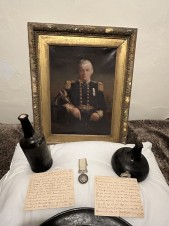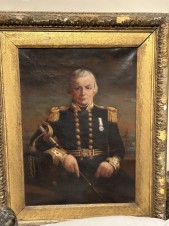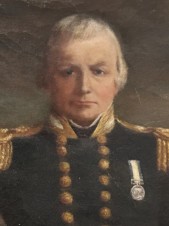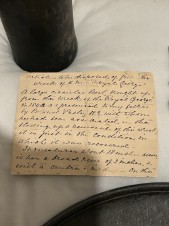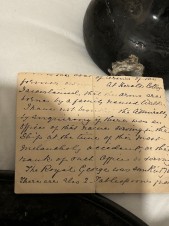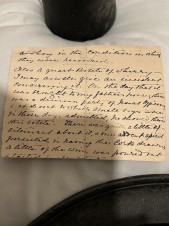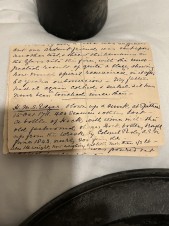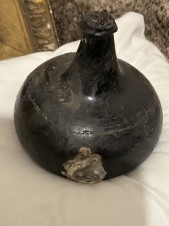NGS MEDAL TO C. BROWN, MIDSHIPMAN. TOGETHER WITH HIS OIL PORTRAIT AND OTHER TROPHIES
Stock No. 128309
Approx. USD 10,795.00
Approx. EUR 9,860.00
Product Information
ON CONSIGNMENT – The Naval General Service Medal with Guadeloupe clasp to C. BROWN, MIDSHIPMAN. together with his portrait in oil & Naval Salvage Trophies. Commander Brown (1789-1869), the Master of HMS Warspite, was the first to circumnavigate the globe in a British ship of the line. When news reached London that the Warspite had arrived safely in Portsmouth on July 28th 1827, the High Admiral, later William IV, coached down from London to give his congratulations. The NGSM and clasp relate to his service on the Lorna schooner at the taking of Guadeloupe in 1810, where he was frequently employed in her boats in the capture of enemy vessels. His c. 1875 portrait by the then-renowned copyist, Isabella May, is believed to be a copy of an original painting, or an original work based on his photograph. Provenance – by direct descent through the family. NAVAL AND MILITARY GAZETTE – Saturday 31 July 1869 Commander Charles Brown, R.N., died at 55 Hans Place, S.W., on July 19, aged 80. He entered the Navy on April 5, 1809, A.B. on board the Laura schooner, Lt-Com. C.N. Hunter. While attached to that vessel, of which he became Midshipman in the following September, and Master’s Mate in October 1811, he assisted at the reduction of Guadeloupe, was much employed in her boats, and contributed to the capture of many vessels. On the evening Feb. 18, 1811, he was sent from Antigua to cruise off the island of St. Bartholomew, in a 25ft. cutter, carrying a small brass gun and ten men. At daylight the next morning, a heavy gale having sprung up during the night, the boat went down, about seven or eight miles from the island of St. Kitts. Turning out the gun, ballast, &c., she fortunately came to the surface again, and enabled Mr. Brown and five others, by occasionally holding on to the keel, remain afloat until, after buffeting the waves for six or seven hours, they were gradually blown on shore exhausted, and much hurt in driving through the surf. Of the five men who perished, one was for some time sustained by Mr Brown, whose failing strength at last compelled him to withdraw his support. In Sept. 1812, while navigating a prize to Halifax, he was captured by the American privateer Saratoga, and taken to New York. Being soon, however, exchanged, he proceeded to Halifax, and returned home thence as a Supernumerary, on board the Africa,64, flag-ship of Vice-Adm. H. Sawyer. From Feb. 1813, until Aug. 1815, he served as Master’s Mate and Second Master in the Duncan, 74, Capts. R. Lambert, T. Ussher, and S. Chambers, which ship, after cruising off Brest and Toulon was ordered to the Coast of Brazil for the purpose of conveying Don John of Portugal to Lisbon and actually bore, for a short time whilst lying at Rio de Janeiro, the flags, simultaneously, of Rear-Adms. M. Dixon and Sir J.P. M. Dixon and Sir J P Beresford. On Aug. 2, 1815, Mr Brown passed the examination for Lieut., and the 6th of the following month he passed the one for Master, to which rank he was on the same day promoted. His succeeding appointments afloat were in nearly continuous succession—Sept. 6, 1815, to the Leveret, 10, Capt. J. Theed, on the St Helena Station; July 10, 1818, and June 3, 1820, to the Bann, 20, Capt. A. Mitchell, and Iphigenia, 42, Capt. H. Parker, both in the West Indies; Nov. 5, 1821, to the Andromache, 44, bearing the broad pendants of Commodores J. Nourse and C. R. Moorsom, at the Cape of Good Hope; Sept. 9, 1825, to the Warspite, 76, which ship he served in the East Indies under the flag of Rear-Adm W. H. Gage and the broad pendant of Sir J. Brisbane, returned home under the command of Capt. Hon. R. S. Dundas, and was further employed under the flag of Sir E. Codrington, in the Mediterranean; Jan. 21 and Sept. 17, 1829, and May 1, 1830, to the Kent, 78, Capt. J. F. Devonshire; St Vincent, 102, flag-ship of the Earl of Northesk, and Caledonia, 120, bearing the flags of Sir M. Dixon and Sir E. Codrington, all on the Homo Station; and Jan. 14, 1832, to the command, which he retained until Nov. 21, 1833, of the Romney troop-ship. When Master of the Bann, Mr Brown surveyed the Lasal Bank, in the Gulf of Mexico; and when in the Andromache at the island of Pemba, on the East Coast of Africa, he accomplished the survey of Chak-Chak Bay, which had been unavoidably left incomplete by Capt. W. F. Owen, of the Leven. He brought the Warspite home through Cook Strait, New Zealand, thus accomplishing the circuit of the globe in a line-of-battle ship, the first that ever performed the voyage. During the time he was in her he surveyed Man-of-War Bay in the island of Egeria. While commanding the Romney, Mr Brown was stationed at Lisbon for the reception of British subjects during the Civil war between Dom Pedro and Dom Miguel. He also visited the West Indies and North America. After he left the Romney he was successively employed—ln examining Warrant Officers’ accounts at the Admiralty, from Feb. 19, 1834, until Sept. 11, 1836; as Assistant Master-Attendant at Chatham from Sept. 12, 1836, until Feb. 9, 1837; at Sheerness from Feb. 10, 1837, until Aug. 22, 1840; and at Portsmouth from Aug. 23, 1840, until June 27, 1846; and as Master-Attendant at Portsmouth from June 28, 1846, until June 28, 1850. He was awarded Commander’s rank on the date last mentioned. Com. Brown had received a medal for the capture of Guadeloupe. .
18th century RN salvage – HMS Edgar (1668) and HMS Royal George (1756) – 3 items of salvage recovered by Maj-Gen Charles Pasley R.E. at Spithead in the early 1840s, together with a note from Sir Charles Gage Brown, describing the articles and the circumstances in which they were presented to his father, Comm. Charles Brown R.N., at Southampton in 1843. (4)Provenance – by direct descent through the Brown family.1. HMS Edgar (sunk in 1711) – a large pewter bowl with the arms of Rear Admiral Sir Hovenden Walker engraved to its rim.2. HMS Edgar (sunk in 1711) – an onion-shaped wine bottle encrusted with part of a seashell.3. HMS Royal George (sunk in 1782) – a bottle of Madeira4. Sir Charles Gage-Brown – a 300-word note explaining how the above were given to his father by Pasley, who was in charge of salvaging and clearing both vessels, which were a hindrance to the Spithead anchorage.The note from Sir Charles Gage Brown reads:Articles to be disposed of from the wreck of the HMS Royal GeorgeA large circular Bowl, brought up from the wreck of the Royal George in 1843 and presented to my father by Colonel Pasley R. E. with whom he had been associated in the blowing up and removal of the wreck, it is just in the condition in which it was recovered.It measures about 18 inches across and has a broad rim of 2 inches, and with a centre 2 in deep – on the rim is the coat of arms of the former owner. At Herald’s College I ascertained that the arms are borne a family named Walker*. I have not troubled the Admiralty by enquiring if there was an officer of that name serving in the ship at the time of the most melancholy accident, or the rank of such officer so serving. The Royal George was sunk in 1782. There are also two tablespoons just in the condition in which they were recovered.Also a quart bottle of sherry – I may as well give an incident concerning it. On the day that it was brought to my father’s house, there was a dinner party of naval officers & at dessert to which small boys were in those days admitted, he showed them this bottle. There was quite a little excitement about it and one ardent spirit persisted in having the cork drawn, a little of the wine was poured out and tasted by all, a taste was sufficient but our ardent friend was bent upon another test, and threw the remains in the glass into the fire, with the unexpected result of quite a blaze, showing how much spirit remained in it after 60 years submersion. My father had it again corked & sealed and it has never been touched since then.**HMS Edgar – blown up and sunk at Spithead 15 Oct 1711. 400 seamen and others lost – a bottle of Hock with wine in it. The old fashioned shaped Hock bottle, brought up from the wreck by Colonel Pasley R.E. in June 1843. Nearly 200 years old. Also 1lb weight, now weighing but little more than ½ lb.* Gage Brown’s note erroneously ascribes the pewter bowl as being salvaged from the Royal George. It was, in fact, as the family later discovered, almost certainly raised from HMS Edgar. Gage Brown took the bowl to the Richmond Herald, Charles Athill, at the College of Arms in London on October 21st 1894 in order to confirm the arms on the bowl were those of the Royal George’s Admiral, Richard Kempenfelt. It appears Gage Brown, half a decade after the salvage had been presented to his late father, had been barking up the wrong tree. Athill followed up with a letter the next day:College of ArmsQueen Victoria Street E.C.21 Oct 1894Dear Sir,With reference to the old pewter bowl which you shewed me yesterday. The Arms are not those of Admiral Kempenfelt, but belong to the family of Walker of Ilam co. Stafford. One of the Walkers was probably an officer with the “Royal George”.Yours faithfully,Charles H. AthillRichmond Herald** ’The ‘sherry’ bottle from HMS Royal George, which is still a third full, was tasted and proven still sound in 1965 by David Rutherford of Rutherford Osborne, Shippers of Madeira, who declared it to be Madeira Sercial. The bottle from HMS Edgar still contains liquid, but I defy anyone able to drink it!’

